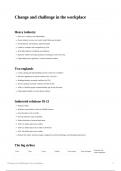Change and challenge in the workplace
Heavy industry
After ww1, industry was underfunded,
Heavy industry in iron, coal- north, South Wales and scotland
Old machinery, old methods, underinvestment
Unable to compete with competitors eg USA
New light industry in midlands and southeast
Eg motor vehicles and mass production techniques such as Ford usa
Light industry new appliances: vacuum, domestic market
Two englands
Cotton, mining and ship-building each lost 1/3rd of its workforce
Electrical appliances increased workforce by 2 and 1/2 x
Building industry increased workforce by 33%
Service industry increased workforce by 40% in 30s
1939- 11.5million people awarded holiday pay for the first time
Older people tended to work in heavy industry
Industrial relations 18-21
Wartime strikes
48 strikes across britain with over 200,000 workers
Even the police went on strike
Pent up injustices at gov unleashed
Strikes declined as factories hired more
1919- 32 million days lost to strikes
1920- 25 million days lost to strikes ( the boom)
1921- 84 million days lost to strikes
Reasons for strikes: repressed wages, rising prices and food shortages, and ideological grievances
The big strikes
Evaluation and
Point Date Group Explain Event turnout Facts and figures
counter arguments
Change and challenge in the workplace 1
, The miners strike 1921 Miners federation Pit owners- lazy Miners working Min owners
of Great Britain greedy; gov with the national locked out
(largest union control of mines transport workers workers on 1st
900.000 members) ended in 1921 and and railwaymen April after
returned to private union- no solution refusing pay cuts.
industry= wages to strikes with Gov used
cut + hours foreign import- emergency
lengthened. threat of a general powers act to send
strike. troops to wales in
anticipation of
violence.
Miners forced to
The triple alliance MFGB refused to
accept pay cuts
NUR, MFGB, sabotage- didnt go allow the other Strike lasted 15th
Black Friday Friday 15th April that left their
NTWF on strike in unions in April- 28th june
wages 20% lower
solidarity negotiations
than in 1914
Meant that union
Left with a lasting Return to gold
militancy arthur cook “not a
Impacts of the sense of grievance standard means
increased when minute on the day
miners strike and X X towards the rest of that mine profits
macdonalds not a penny off
Black Friday the union depleted and
labour gov failed the pay”
movement wages cut further
in 1924
The organisation
for the
maintenance of
The government
supplies- founded
1st may 1926- a was more
Enquiry into to do what the
million miners organised, created
Miners, railway miners conditions- strikers refused to;
across britain propaganda paper
men, dockers, offered subsidy manning buses
The general strike were locked out of the british gazette
1926 iron, steel, until 1 may. 1926. trains and
1926 workplace. TUC and bbc to do
transport workers Forced to then telephones The
announced messages of
and printers accept pay cuts, if unions gave legal
general strike to support; labour
not lockout, immunity from
begin on may 3rd distanced itself
damages claims
from the strike
for loss of profits
not applying-
trades disputes act
A new trades
Wages for the
disputes act 1927-
miners were
Impact of the prevented
slashed and the
general strike sympathetic
industry lost 30%
strikes and mass
of jobs
picketing
The depression
Union revenues depleted
Membership of declined from height of 8 million un 1922 to 4.5million in 1932
CA: National Unemployed workers movement, communist, union grew- but was still small vs MFGB
Union action unable to allievate the conditions in the Clyde, South Wales, Yorkshire and Tyneside or Merseyside.
Changing work opportunities and conditions
Change and challenge in the workplace 2





